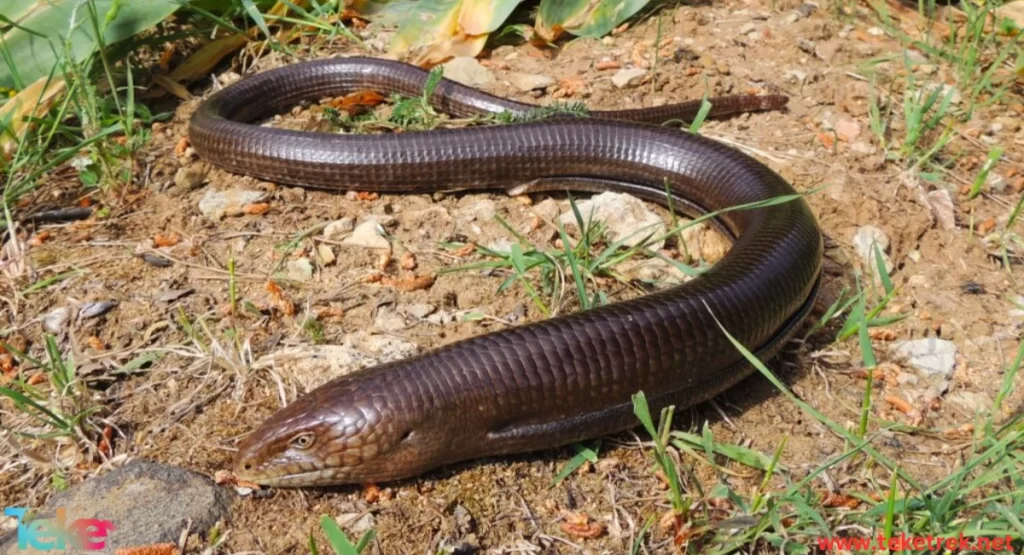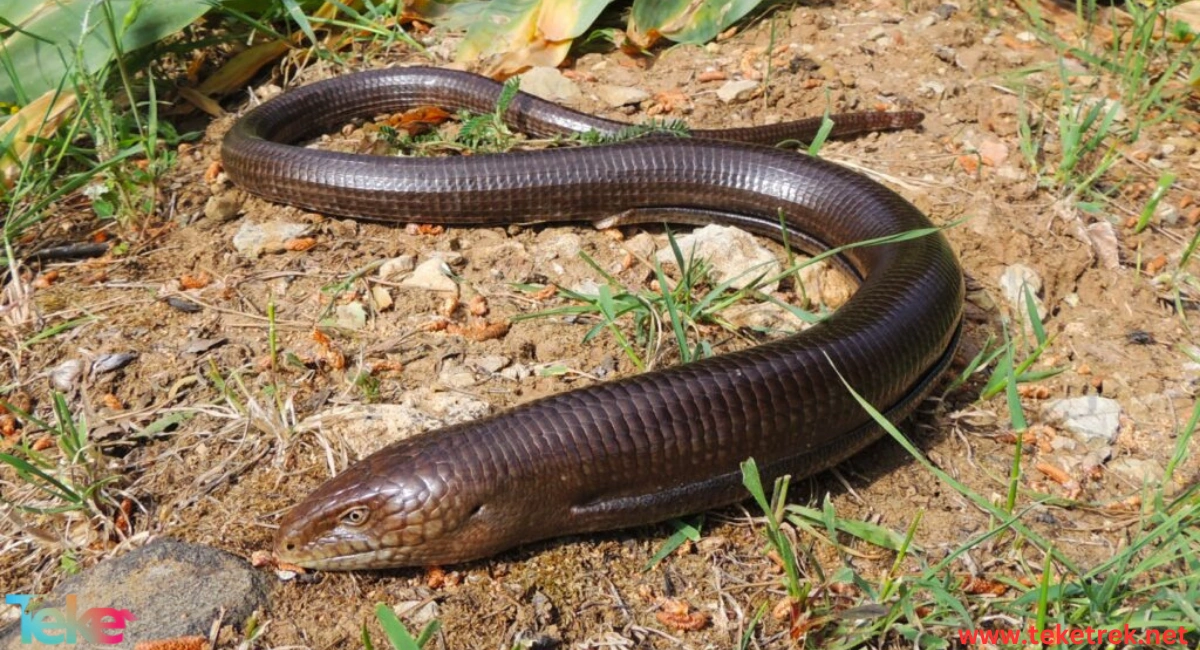The limbless lizard is called the crawling lizard. It is a unique living organism that belongs to the reptile family. This lizard is distinguished by its unique characteristics that make it the focus of attention of scientists and researchers, in addition to its long body compared to other lizards. Since it does not have limbs, it moves through undulating body movements.
Studying this lizard opens new horizons in our understanding of the evolution of organisms and how they adapt to surrounding conditions. Therefore, the limbless lizard is a wonderful example of nature’s ability to create diverse and amazing life forms.Let’s explore more about these fascinating creatures from teke trek.

About the limbless lizard
The limbless lizard belongs to the reptile family and the squamate order, and has the scientific name Anniellida. The limbless lizard is about 40 cm long. Its length can increase to 135 cm in some species. The limbless lizard also has a flat body, a strong tail, and its ability to blend effectively with its environment. These lizards are diverse in terms of beautiful shapes, colors and patterns.
Species of limbless lizard
There are several types of lizards without limbs, and these are some of the famous types:
Budo Sauris lizard (Bipes biporus): It lives in Mexico, and is characterized by its long, slender body and lack of limbs. This lizard lives in the soil and feeds on insects and worms.
Iblisaurus lizard (Dibamus novaeguineae): It lives in the islands of New Guinea, and is distinguished by its longer body compared to other lizards. In addition to having no limbs. This lizard lives in rainforests and feeds on insects.
Cherokee lizard (Chirotes canaliculatus): It lives in North America and is distinguished by its long body. This lizard also lives in the soil and feeds on worms.
Limbless striped anchid lizard: This lizard is considered one of the rare species. It is small in size compared to others, as its length and tail reach 18 cm. There is not enough information available about it in terms of its environmental activity, whether diurnal or nocturnal. But they are found hiding under rocks. It feeds on small invertebrates and insects. Its distinction comes from its method of reproduction, as it does not lay eggs, but rather gives birth to its young.
Glass lizard: It is classified among the types of limbless reptiles for several reasons, the most important of which are:
1- The head shape resembles that of a lizard
2- Having eyelids around the eyes.
3- The presence of external ear slots.
4- Its tongue is thicker and wider, in addition to having a small anterior bifurcation.
5- It has a long tail and a short body.
6- It does not contain poisonous fangs, as it is satisfied with the force of its bite while hunting.
Abu Qara lizard:
Sometimes called Barkil, it is one of the largest species of lizards found in the Levant. Its length reaches 135 cm. It is peaceful and non-toxic, and feeds on arthropods and small mammals. It prefers snails and slugs.
What is the diet of a limbless lizard?
The limbless lizard feeds on a variety of foods, including insects, small worms, and fleas, as well as locusts, small snakes, bird eggs, seeds, and fruit. Their food choices depend on the environment in which they live. Therefore, limbless lizards are beneficial to the environment, because they feed on small, annoying creatures and control their numbers.
Method of reproduction of the limbless lizard
The limbless lizard reproduces through direct fertilization, where the male and female meet to produce eggs that hatch into young ones. The eggs are laid in appropriate places such as sand, soil, or under rocks. After a short period, the children emerge and begin their journey in the outside world. Some species live up to approximately 50 years.
Lizard habitite
Some factors that affect the reproductive process of the limbless lizard:
The environment in which the limbless lizard lives, where there are suitable conditions for reproduction, including temperature, humidity, and the presence of food.
Biological factors such as the age and health condition of the lizard affect its ability to reproduce.
Behavioral factors play an important role in stimulating reproduction, such as sexual roundness and male display.
Its role in the ecosystem:
Limbless lizards affect the surrounding environment in many ways. These lizards devour harmful insects and rodents, which reduces their reproduction and spread. This contributes to the protection of agricultural and wild plants. In addition, limbless lizards play an essential role in the food chain and are called secondary predators. As it could be food for birds and snakes.
The primary habitat of the limbless lizard
Where do legless lizards live?
The limbless lizard is found in different regions of the world. They live in diverse
environments, including deserts, forests, mountainous areas, and agricultural lands. There are also some species that live in equatorial and tropical regions. While other species are found in sub-continental and temperate regions. Among the places where limbless lizards can be found are:
The Arabian Peninsula.
Australia.
Africa.
south america.

FAQs about the limbless lizard:
We will now ask some common questions that some people interested in studying and understanding the life of the limbless lizard search for. Here are the most important ones:
1- Is the limbless lizard warm-blooded?
No, they are not warm-blooded, as this characteristic is found in some animals. As its temperature rises, it evaporates to maintain an ideal temperature, and this is done through sweating or panting. This does not exist in the limbless lizard.
2- What is the breathing pattern of the limbless lizard?
The limbless lizard breathes through its skin and the mucous membrane and thin skin that surrounds it. In addition, it has a simple lung breathing system represented by spiracles in its body.
3- Can lizards breathe underwater?
Yes, you can, and it is done through a bubble of air trapped in the nose or head. It has been observed that it holds its breath for up to 16 minutes underwater.
4- How can humans protect the limbless lizard?
These lizards are considered not directly harmful to humans as they are non-venomous. But it could spoil some of his crops. Therefore, they can simply be moved away from farms and left to live, because they clearly contribute to the environmental balance.
5- How does a lizard protect itself?
The lizard protects itself by skin color and camouflage.
What is the nickname for the legless lizard?
The legless lizard is known as the glass lizard.
In conclusion, it can be said that limbless lizards are amazing creatures that arouse
amazement and admiration. These creatures are distinguished by their ability to adapt to difficult environmental conditions and survive despite the fact that they do not have limbs.
Let’s learn more about limbless lizards and share the knowledge with others, because our understanding of nature’s organisms contributes to preserving the biodiversity and beauty of this wonderful world.





